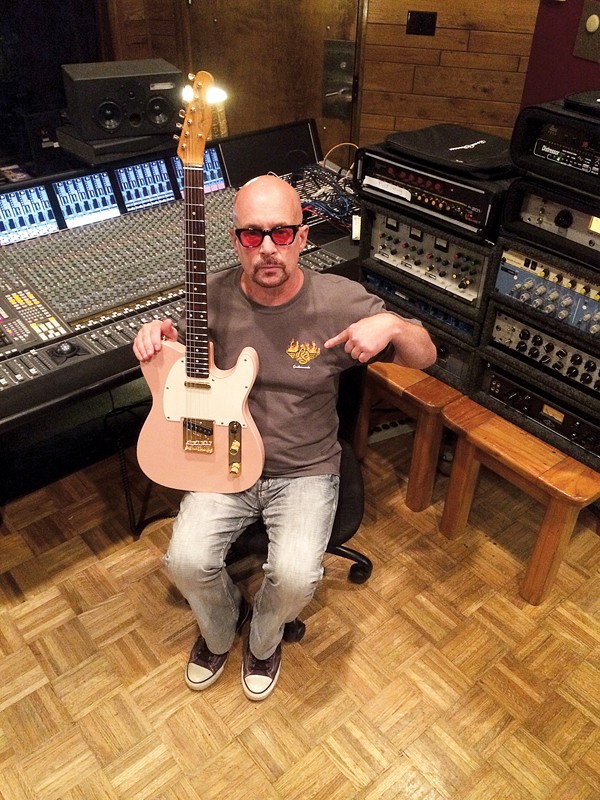When Robert Johnson — not that Robert Johnson, but stick with me — sent over a Beatles tribute project, I put it with all of the other Beatles projects that I don’t want to think ever existed. That was a mistake. Johnson has one of Memphis’ most colorful musical resumes, and his colorful 2014-2015 calendar features the work of Alan Aldridge, the illustrator of the Beatles’ 1969 illustrated lyric book and other iconic images, including the original Hard Rock Café logo. The package comes with a 45-rpm record of Beatles tunes produced by Johnson. You can order the calendar here.
Johnson’s background in Memphis music is something to behold in itself.
“I grew up with David Cartwright, whose son is Greg,” Johnson says of his remarkably musical childhood neighborhood on the west side of Frayser. “When I was about 13 or so, I had a band called the Castels at Westside High School. In summer and spring, we used to cut [Elvis’ bass player] Bill Black’s grass. He had Lyn-Lou Studio. But we had two or three years as kids just hanging out over at Bill Black’s house. His kids were my age. Then we had Roland Janes as a neighbor. He had Sonic Studio. We got started with him back in ’63 or something. It was next door to Audiomania.”
Westside High School was another fountain of musical culture.
“Near Westside’s ballpark in the back of the school there was a cotton patch and then an old house, and that’s where Bobby ‘Blue’ Bland lived,” Johnson says. “Ronny Scaife, who became a well-known songwriter in Nashville and wrote songs for Garth Brooks, Mongtomery-Gentry. Ronny was in the 1960s bands with us. It was a unique neighborhood.”
By the time John Fry opened Ardent Studios on National in 1966, Johnson was still a kid, but also a seasoned guitarist, who had already worked at Lin-Lou, Sonic, and Phillips Recording.
 Courtesy of Robert Johnson
Courtesy of Robert Johnson
Robert Johnson
“We started hearing about Ardent,” Johnson says. “The first time I went, I met Terry Manning, probably about 1969. Terry Manning heard my band play at the Overton Park Shell and wanted to sign us to Ardent Productions. We started making an album there with a band called Country Funk. Then we opened up for Steppenwolf and the Byrds at the Coliseum. It was a sold-out place. After that, we were on Ardent’s roster. That’s where we got started working at Ardent. I went from there to a band called Alamo with Larry Raspberry, Richard Rosebrough and Ken Woodley. That’s where the whole pack started with [Alex] Chilton and Woodley. That’s kind of like the original little clique over there.”
Johnson also worked in the Stax mailroom alongside William Brown of the Mad Lads. That led to his recruitment to Isaac Hayes’ first band supporting the skyrocketing album Hot Buttered Soul.
“Hot Buttered Soul sold a million copies in 30 days,” Johnson says. “Then in six weeks it had gone platinum. He had a songwriting obligation, so he had to show up to write songs. So we could only go out and play on the weekends, which was good for me because I was still in high school.”
Hayes eventually formed the Isaac Hayes Movement, and the core of the old band — Johnson, bassist Roland Robinson, and drummer Jerry Norris — became Steel. After bouncing around for a spell and backing Ann Peebles with Alex Chilton, Johnson ended up in England, where he caught the attention of John Entwistle and became a member of John Entwistle’s Ox, the Who bassist’s solo project following Tommy. During that time, he recorded a record with the improbable personnel of Bill Bruford from Yes and King Crimson on drums, Entwistle on bass, and Stones pianist Nicky Hopkins on piano.
“Nicky came up to me at the sessions at Wessex Studios and said, ‘Hey, I was at the Rolling Stones office today. Mick Taylor quit the band.’ I actually learned about that the day it happened,” Johnsons says. “Around the fall of 1974. He said, ‘I’ll give your number to Mick Jagger if you want me to.’ Of course, I never thought a thing about it. A couple of weeks later, Jagger called my house in London. He asked me to come over to Rotterdam Holland to ‘have a play,’ as he said. So I went over there and spent four days with them and the mobile studio and Glynn Johns and everybody.”